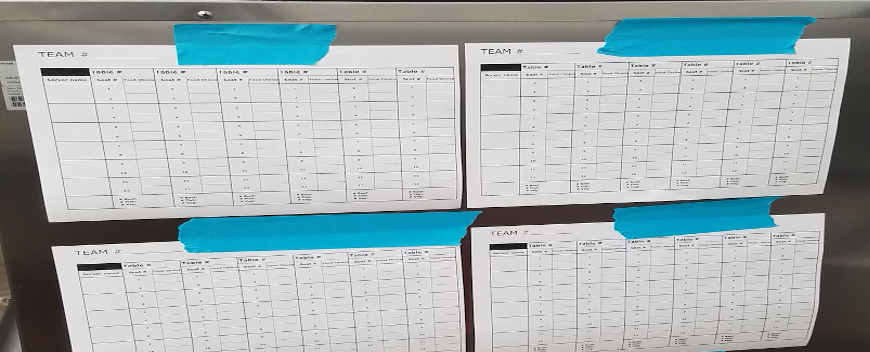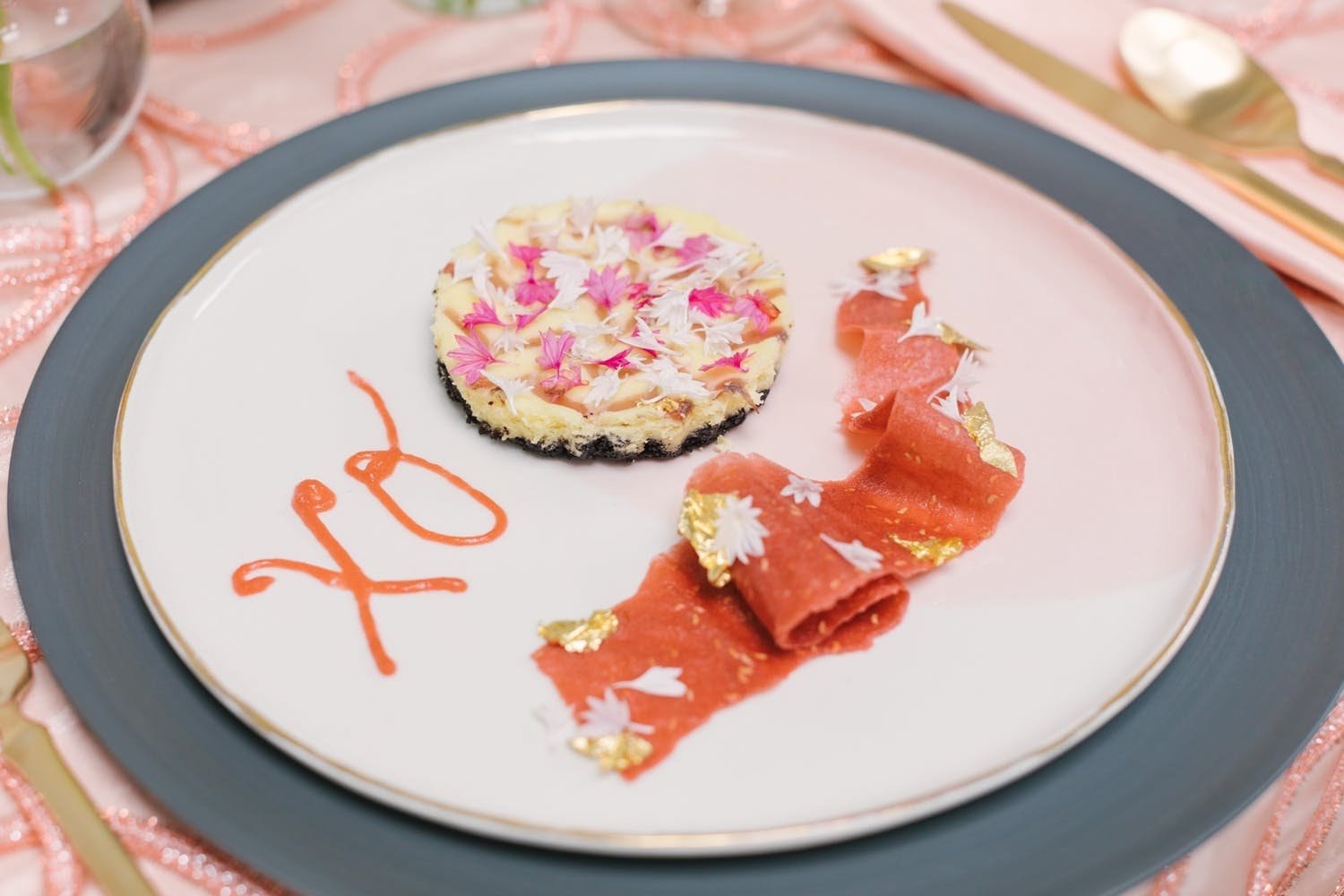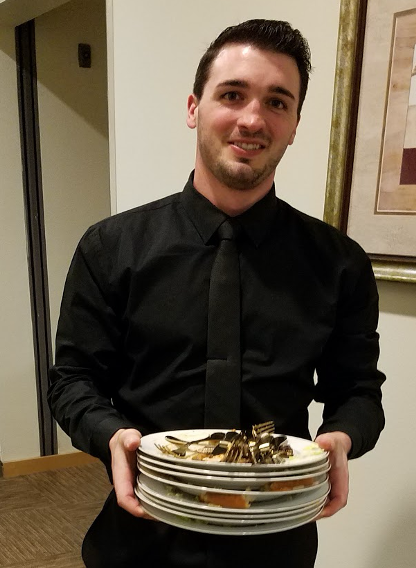As a guest enters the dining room, one of them asks you, “Where’s the buffet?” You reply, “Today there is a special plated service. We’ll bring the courses to you at your table.”
A plated service means the food is carefully prepared in the kitchen and then delivered by a server to the guests seated at a table. Sometimes people call it “sit down service,” However, “plated” is the proper term.
Plated service requires that all servers follow specific rules of etiquette to create an atmosphere of fine dining. These rules were introduced to France by Catherine de Mediciin the 1500’s and still govern how tables are set, how courses are served, and how courses are eaten. By implementing these rules of etiquette, servers set the tone for plated service.
Hospitality in the food & beverage industry is always about the experience. Plated service is a key element in a fine dining experience!
Summary
This informative document covers the basics of serving and clearing a plated meal. For new staff, it includes a review to introduce what works best. For veteran servers, this document provides a quick refresher on proper protocol.
Seven key takeaways:
- Rely on the pre-event meeting and one-sheet to get important details
- Confirm or get meal orders for your table
- To serve: Left, Lower, & Leave!
- To clear: Right, Remove, & Raise!
- Always be clearing throughout service to keep tables clean
- Clear glassware one type at a time, as directed by the Zone Captain
- Help others when your tables are done
Pre-event Meeting: What Servers Need to Know
The pre-event meeting covers all of the most vital information servers need to know to make an event successful. Below are the most important points that must be noted when plated service is in play:
- Zone Assignment & Captain: This is the zone-section of the dining area where you will be assigned to work. Each section will have a Zone Captain, who you’ll report to for directions.
- Partners or Team: This is a list of the other servers you’ll be working with if there are other servers who have been hired for this event.
- Table Assignment(s): This information includes the tables you’ll be serving as well as your other responsibilities for the event such as food service, beverage service, and table clearing.
- Table Cover Positions: The table cover positions are defined differently for circular, square, and differently shaped tables. Servers must know where position #1 is located. Position #1 is usually facing North, the head table, or a stage. Later when a special request needs to be handled, the direction of “Table 3, Cover 4” is easy to follow.
- Place or Escort Cards: Servers must know if the place-escort cards are set-out and whether or not the cards indicate the guests’ preselected meal. Place cards are put on the dining tables indicating where a guest is to be seated. Escort cards are placed on a table near the entrance for the guest to collect and indicate which table they are assigned to.
- Service Methods: Follow different service models, which can include: solo, A & B waiters, zone or area sweep, serving team, or restaurant switch out. We’ll discuss these methods and processes in another post.
- TCO (Table Cover Order): Organizes and confirms the meal that has been selected at the table(s). This information is relayed to the Expeditor at the pass.
- TSO (Table Service Order): Unless a Captain directed sweep, this document also summarizes what guests ordered by cover position as well as the server and the order in which the tables are served.
- Menu: What is being served, the course order, and potential allergens and alternative options.
- Schedule: Know the order and location of activities during the event and when you’re expected to be on and off the floor.
- Pass Location: The pass is where prepared dishes transfer from the BOH (Back of House) to the FOH (Front of House).
- Oval Banquet Trays: Servers must know if oval trays with tray stands are used to serve and or clear tables.
- Scullery Location: This is the space allocated for dirty plates, flatware and glassware.
- Service Station Location(s): This is where extra, flatware, glasses, water, wine, condiments, etc. are stored for service.
- Clearing Pace: This is the pace at which the tables are to be cleared for the next course. Pacing may be casual, 60-80-100%, assertive, or aggressive.
Getting and Confirming Orders

Generally the entrée is preselected by the host-planner, as a single or double entrée. Often, guests will pre-select a protein and their order is indicated on the place/escort card. For example:
- Star = Beef
- Cross = Chicken
- Etc.
How to Use TCO (Table Cover Order) Sheets to Confirm Meals
At events where guests have preselected their meal choice, every guest meal choice must be confirmed by servers to avoid serving an incorrect meal to a guest. Use a TCO (Table Cover Order) sheet or order pad to confirm the guests order at each position.
Keep an eye out for when the guest:
- Doesn’t have a meal choice indicator
- Moves to a different position and doesn’t move the place card with them
- Changes their mind about their order
- Is seated without the card because assignments is listed elsewhere
Meal Confirmation Protocol
- As the guests are seated, the assigned server approaches the table.
- The server welcomes guests and confirms each guests’ meal choice (e.g. “Hello. Just confirming your meal selection. Are you having the Fresh Branzino or the Free-range Chicken Kiev?”)
- After the guest responds, the server says, “Thank you.” and records the selection on the TCO sheet. Once the meal selections are confirmed with guests, the information is then relayed to the Expeditor. The server or the expeditor enters the meal selections on a TSO (Table Service Order).
TCO Sample:
B = Beef, C = Chicken, F = Fish, V=Vegan
4. Once the meal selections are confirmed with guests, the information is then relayed to the Expeditor.

5. The server or the expeditor enters the meal selections on a TSO (Table Service Order).

6. As meals are served to the tables, the TSO is marked - so we know which tables and guests have received their orders.
Serving the Plates

Collect plates from The Pass or from large oval trays on tray stands that are delivered to a location close to the guests’ table.

How to Serve Hot Plates to Guests
Tip: Protect yourself and the guests! When the plates are hot, white gloves or folded linen napkins are issued as “hot pads” to carry the plates. Dinner napkins are folded neatly into triangles to act as “hot pads.”

Review the posted TCO for all orders and specifics according to the table and position. Know the contents of the plate and how it is to be placed in front of the guests. Usually the protein is placed at the 6 o’clock position - meaning closest to the guest. If you have not received instructions on plate placement, ask. But, do not rotate plates in front of the guests!
Remember to:
- Review each plate’s presentation quickly for garnish, drips, spills, or smears. Plates need to be presented to guests in the best possible way.
- Remember to ask, “Is this plate ready?” unless the expeditor directs you to pick up.
- Pick up the first plate with your right hand with the folded linen hot pad. Pick it up so that it’s easy to transfer to the left hand for serving later.
- Pick up the other plate using folded linen hot pad in the left hand, so that it is ready to be placed in front of the guest. Meaning, your left hand should be holding onto the plate at the 8 o’clock position. Proceed to join the sweep, a serving team or proceed directly to the tables(s). Keep plates level.
How to Serve Salad Plates, Warm Plates, or Unheated Plates

As you collect the plates, position your fingers on the underside to pull the edge rim in firmly toward the space against your palm - just below your thumb. Keep plates level, so sauces and juices don’t run.


Remember to:
- Keep your thumbs and fingers off the rim.
- Limit pick up to two plates.
- Proceed to the table to serve as part of the serving team or the sweep.
Guidelines for Serving: Left, Lower, & Leave!
Serve with the left hand. This means that, with rare exceptions, you’ll serve guests from their left side with your left hand. This service style is referred to as “American Service.”
- Left - Approach the guest from their left side so that you are embracing or facing them. Step in with your left foot and extend your left hand.
- Lower - Lower and place the plate in its proper position gently in front of the guest.
- Leave - Announce the name of the item being served and say, “Please enjoy!”
In addition to these 3 rules, also remember to:
- Avoid reaching across a guest to serve them or another guest, unless there is a physical barrier in the way.
- Step back with the right foot behind the guest and move counter clockwise (right) to the next guest. Transfer the plate from the right hand to the left hand and repeat.
The Service Procession “AKA” Post and Sweep
Collect your plates and look for the Zone Captain (Post), who will direct you to which tables to serve. In this case, all servers will form a continuous stream (Sweep) as a team delivering plates from table to table.
NOTE: Unless directed otherwise, if a guest makes a special meal request, you will drop out of the serving procession and handle the meal request and then rejoin the sweep team.
Always Be Clearing (ABC): Right, Remove, & Raise!
First, listen for the clearing directives! For example, a “Relaxed” clearing directive means that the servers wait for 60-80-100% of the table to be finished eating before clearing. In contrast, an “Aggressive” clearing directive means servers start clearing the table as soon as the fork is placed on the plate.
- Right: Face and embrace the guest from their right side. Know the signs that indicate the guest has finished eating the most current course. When in doubt, politely ask, “May I clear your plate?”
- Remove: Collect flatware with the right hand and transfer it to the left hand to secure it between the little finger and thumb. This method keeps the tables neat, leaves less to clear later, it avoids flatware sliding off plates when en route to the scullery. When clearing, remove only the salad plate along with the smaller, salad fork, and a knife. At some events, the staff may be instructed to leave a single knife or fork for additional courses.
- Raise: First, secure flatware in your left hand, between your little finger and thumb. This holds the flatware secure and allows the fingers to balance the plate. This method prevents the flatware from sliding off plates while walking to the scullery and it encourages faster sorting at scullery. Avoid “Plate Clearing Olympics” of gathering and stacking several plates at one time. Stacking as much as you can is unprofessional, and will take longer to clean if there’s an accident.

NOTE:
- Listen for clearing and speed directions during the pre-event meeting or as directed by the Zone Captain during service. Avoid “stacking” and “plate clearing olympics.” Clear only two plates at a time.
- The clearing speed may change during the event due to the timing of activities, speeches, presentations, etc.
What To Do With the Decorative Plate “aka” Chargers
Chargers are the large decorative plate “aka” chop or, service plate. The charger’s purpose is to handle drips and spills from the plates. The charger stays on the table until the last entrée is cleared.
Generally, the charger is cleared together with the entrée plate and the flatware. Then dessert is served after the charger and the other plates have been removed.
From time to time, a directive is issued to clear the entrée plates and flatware and then chargers are removed separately. This two-step method is used to facilitate the processing and packing of chargers in the scullery.
Avoiding Glassware Gridlock: The Scullery

It’s easy for a guest to gather a variety of different glassware during service. At the same time, sculleries are notoriously cluttered. Clear cocktail glasses during service. Leave the wine glasses, water goblets and champagne flutes on the table, until called for.

When it’s time to clear, wait for direction from the Zone Captain to clear the specific glassware and then only remove one type of glassware at a time as called for. Always use a round tray to transport glassware from a table to scullery. Avoid sticking your fingers inside any glasses.

This “one-type-at-a-time” method moves large volumes of glassware through the scullery quickly with little or no breakage.
If a guest declines wine service, remove their wine glass so they are not repeatedly asked about wine leave the champagne flute, water goblets, and wine glasses on the table until the end of service.
Lastly, remove the china, napkins, flatware, debris, salt & pepper shakers off the tables. Ask about clearing centerpieces.
Final Tips
Servers play a vital role during events. When they properly execute the rules of etiquette and follow protocol, they add ambience and charm to the dining experience. Remember to:
- Pay attention to pre-event intel notes.
- Serve from Left, Lower, & Leave.
- Clear from Right, Remove, & Raise.
- Help others when your table(s) is done.
- Be present, have fun, and smile!
By following some simple rules, asking questions when something isn’t clear you’ll not only provide a spectacular experience for guests, but they also make the work experience easier and more enjoyable for the entire team.








